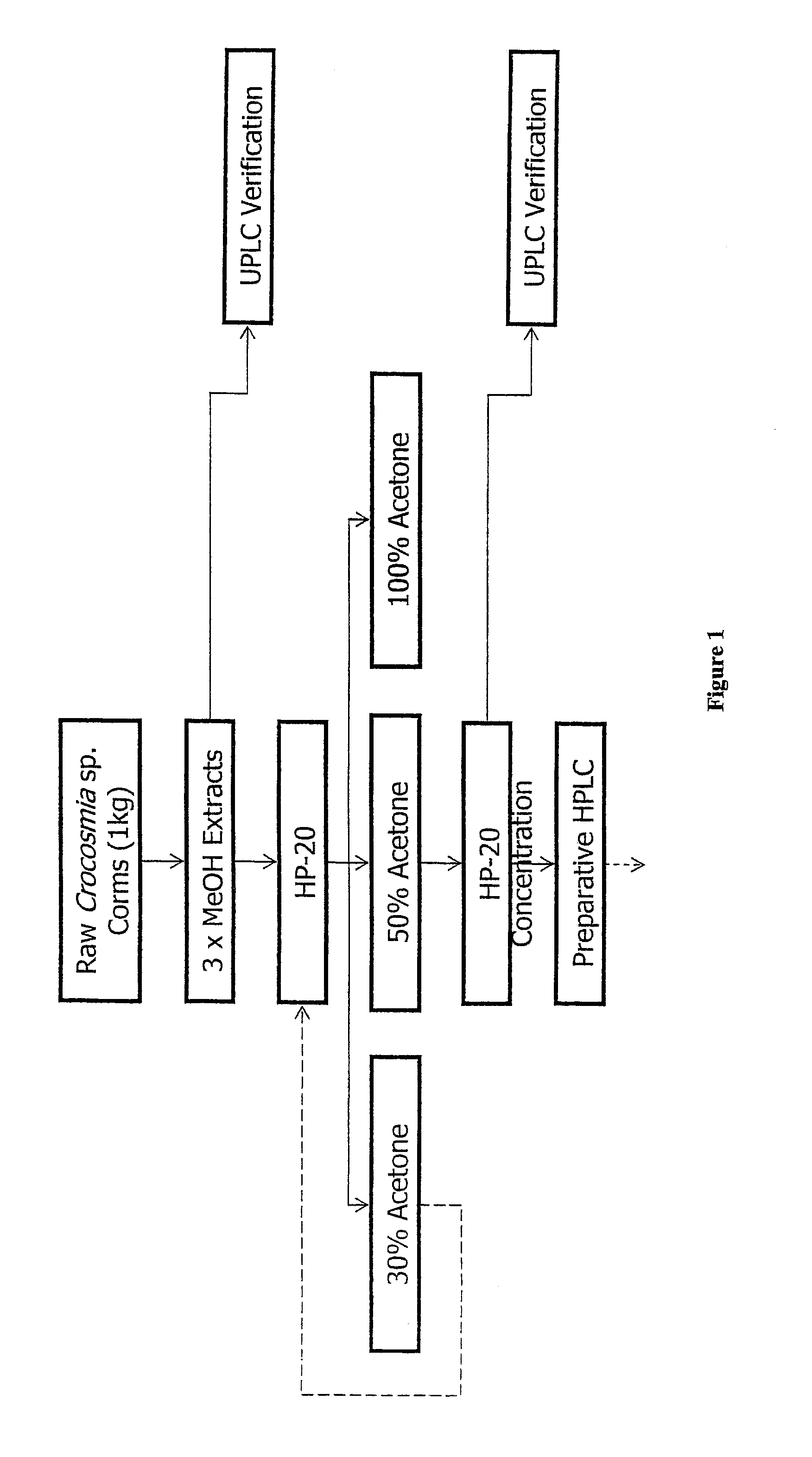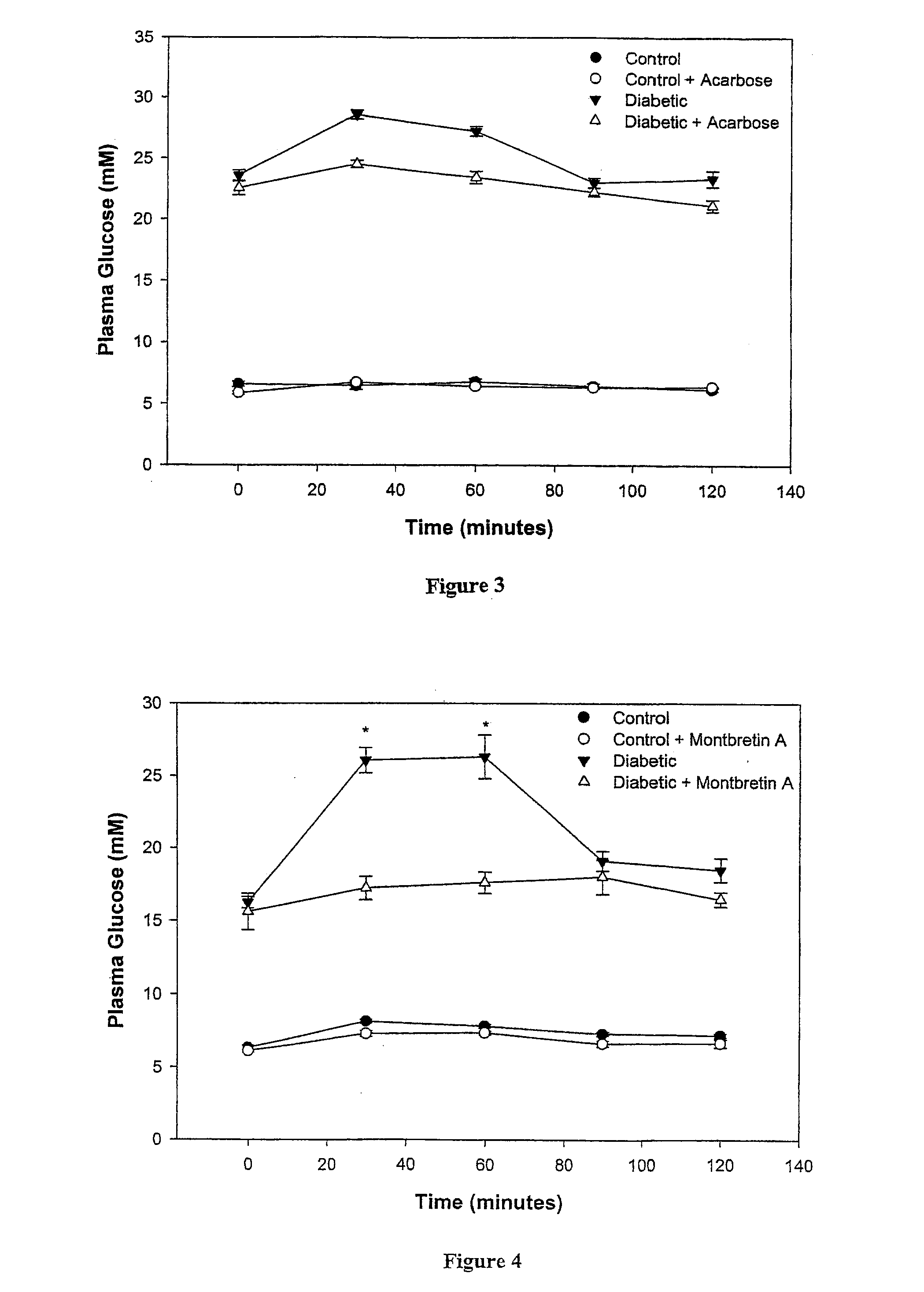Alpha-amylase inhibitors: the montbretins and uses thereof
a technology of alpha-amylase and montbretin, which is applied in the direction of chewing gum, drug compositions, metabolic disorders, etc., can solve the problems of limited effectiveness of alpha-amylases, and achieve the effect of high selectivity
- Summary
- Abstract
- Description
- Claims
- Application Information
AI Technical Summary
Benefits of technology
Problems solved by technology
Method used
Image
Examples
example 1
HPA Inhibition Screening
[0040]The assay for HPA activity was based upon the enzymatic cleavage of a synthetic aryl glycoside substrate to yield a chromophoric product, the release of which can be monitored in a continuous fashion. The commercially available amylase substrate 2-chloro-4-nitrophenyl α-D-maltotrioside (CNP-G3) is used since the pKa of the chloronitrophenyl leaving group (pKa 6.4) is considerably lower than the pH value of the assay (pH 7.0), hence a high extinction coefficient for the chromophore is obtained. The assay solution also included Triton X-100™ (0.01%) to minimize the detection of promiscuous inhibitors. The samples in the initial screen were DMSO solutions containing 5 mg / mL of dried methanolic extracts, tested at a dilution of 60 nL in a final assay volume of 60 μL (5 μg / mL final extract concentration). The enzymatic activity of HPA was found to be completely unaffected by the addition of this small amount of DMSO (0.1%) and Triton X-100™ (0.01%). Each sam...
example 2
Bio-Assay Guided Isolation of HPA Inhibitors
[0044]The extract from Example 1 with the most significant inhibitory activity (2% residual activity) was selected for further study. Prior to detailed investigation of the active components, a preliminary kinetic analysis of the HPA inhibition was performed on the crude extract. A dilution series showed a semilogarithmic sigmoidal dose-response curve typical of a “well-behaved” inhibitor, and revealed a very low IC50 value of 0.54±0.01 μL / 100 μL (extract volume / assay volume). Additionally, the crude extract showed no time-dependent inactivation of HPA, with the level of inhibition remaining constant for over 4 hours. These tests indicate an absence of undesirable modes of action such as enzyme denaturation or covalent enzyme modification. This extract was a dried methanolic extract of the bulbs from Crocosmia sp.
[0045]In order to isolate the principal bioactive components from the complex mixture of the extract, a series of bioassay-guide...
example 3
[0054]The Ki values and mode of inhibition of montbretin A, myricetin and ethyl caffeiate were determined by measuring the rate of reaction at differing inhibitor concentrations for a series of substrate concentrations. Reactions were performed on either a Varian Cary300™ or Cary4000™ UV / Vis spectrophotometer at 400 nm. The substrate concentration (CNP-G3) was typically varied from ⅕ to 5 times the KM value. A similar range of inhibitor concentrations was attempted but some limitations were encountered. The lowest concentration of montbretin A that could be measured was 4 nM (½ the Ki value) due to the very low enzyme concentration required to remain significantly below the inhibitor concentration. Conversely the limited aqueous solubility of myricetin and ethyl caffeiate meant that the highest inhibitor concentration determined for these compounds was 1.5 times the Ki value. Double reciprocal plots of the data for montbretin A and myricetin indicated both compounds ...
PUM
| Property | Measurement | Unit |
|---|---|---|
| pH | aaaaa | aaaaa |
| concentration | aaaaa | aaaaa |
| concentration | aaaaa | aaaaa |
Abstract
Description
Claims
Application Information
 Login to View More
Login to View More - R&D
- Intellectual Property
- Life Sciences
- Materials
- Tech Scout
- Unparalleled Data Quality
- Higher Quality Content
- 60% Fewer Hallucinations
Browse by: Latest US Patents, China's latest patents, Technical Efficacy Thesaurus, Application Domain, Technology Topic, Popular Technical Reports.
© 2025 PatSnap. All rights reserved.Legal|Privacy policy|Modern Slavery Act Transparency Statement|Sitemap|About US| Contact US: help@patsnap.com



